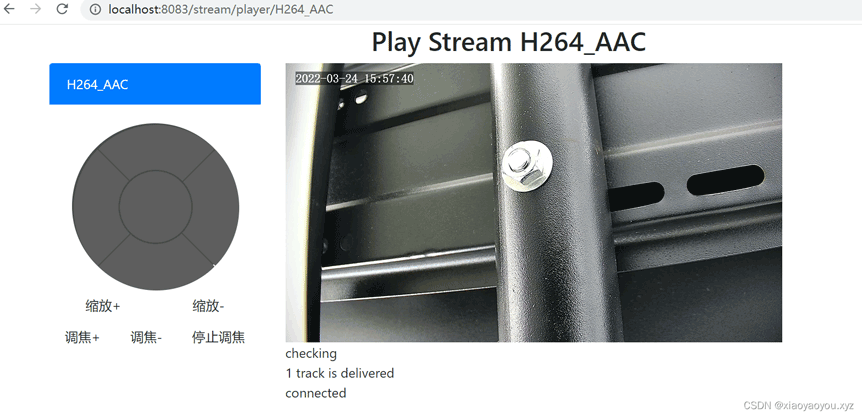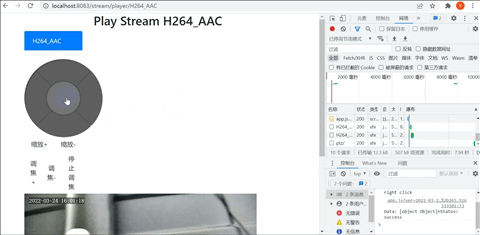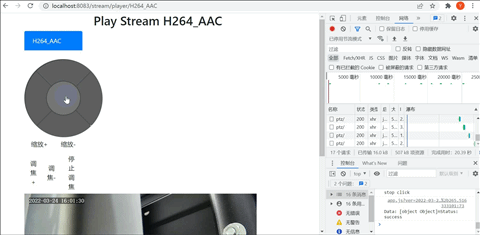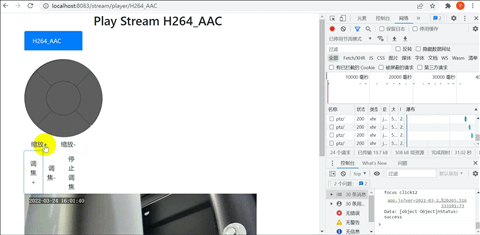Go语言开发浏览器视频流rtsp转webrtc播放
来源:脚本之家
时间:2022-12-24 21:42:49 203浏览 收藏
本篇文章主要是结合我之前面试的各种经历和实战开发中遇到的问题解决经验整理的,希望这篇《Go语言开发浏览器视频流rtsp转webrtc播放》对你有很大帮助!欢迎收藏,分享给更多的需要的朋友学习~
1. 前言
前面我们测试了rtsp转hls方式,发现延迟比较大,不太适合我们的使用需求。接下来我们试一下webrtc的方式看下使用情况。
综合考虑下来,我们最好能找到一个go作为后端,前端兼容性较好的前后端方案来处理webrtc,这样我们就可以结合我们之前的cgo+onvif+gSoap实现方案来获取rtsp流,并且可以根据已经实现的ptz、预置点等功能接口做更多的扩展。
2. rtsp转webRTC
如下是找到的一个比较合适的开源方案,前端使用了jQuery、bootstrap等,后端使用go+gin来实现并将rtsp流解析转换为webRTC协议提供http相关接口给到前端,通过config.json配置rtsp地址和stun地址:
此外,还带有stun,可以自行配置stun地址,便于进行内网穿透。
初步测试几乎看不出来延迟,符合预期,使用的jQuery+bootstrap+go+gin做的web,也符合我们的项目使用情况。
3. 初步测试结果
结果如下:

4. 结合我们之前的onvif+gSoap+cgo的方案做修改
我们在此项目的基础上,结合我们之前研究的onvif+cgo+gSoap的方案,将onvif获取到的相关数据提供接口到web端,增加ptz、调焦、缩放等功能。
我们在http.go中添加新的post接口:HTTPAPIServerStreamPtz来进行ptz和HTTPAPIServerStreamPreset进行预置点相关操作。
以下是部分代码,没有做太多的优化,也仅仅实现了ptz、调焦和缩放,算是打通了通路,具体项目需要可以再做优化。
4.1 go后端修改
增加了新的接口,并将之前cgo+onvif+gSoap的内容结合了进来,项目整体没有做更多的优化,只是为了演示,提供一个思路:
http.go(增加了两个post接口ptz和preset,采用cgo方式处理):
package main
/*
#cgo CFLAGS: -I ./ -I /usr/local/
#cgo LDFLAGS: -L ./build -lc_onvif_static -lpthread -ldl -lssl -lcrypto
#include "client.h"
#include "malloc.h"
*/
import "C"
import (
"encoding/json"
"fmt"
"log"
"net/http"
"os"
"sort"
"strconv"
"time"
"unsafe"
"github.com/deepch/vdk/av"
webrtc "github.com/deepch/vdk/format/webrtcv3"
"github.com/gin-gonic/gin"
)
type JCodec struct {
Type string
}
func serveHTTP() {
gin.SetMode(gin.ReleaseMode)
router := gin.Default()
router.Use(CORSMiddleware())
if _, err := os.Stat("./web"); !os.IsNotExist(err) {
router.LoadHTMLGlob("web/templates/*")
router.GET("/", HTTPAPIServerIndex)
router.GET("/stream/player/:uuid", HTTPAPIServerStreamPlayer)
}
router.POST("/stream/receiver/:uuid", HTTPAPIServerStreamWebRTC)
//增加新的post接口
router.POST("/stream/ptz/", HTTPAPIServerStreamPtz)
router.POST("/stream/preset/", HTTPAPIServerStreamPreset)
router.GET("/stream/codec/:uuid", HTTPAPIServerStreamCodec)
router.POST("/stream", HTTPAPIServerStreamWebRTC2)
router.StaticFS("/static", http.Dir("web/static"))
err := router.Run(Config.Server.HTTPPort)
if err != nil {
log.Fatalln("Start HTTP Server error", err)
}
}
//HTTPAPIServerIndex index
func HTTPAPIServerIndex(c *gin.Context) {
_, all := Config.list()
if len(all) > 0 {
c.Header("Cache-Control", "no-cache, max-age=0, must-revalidate, no-store")
c.Header("Access-Control-Allow-Origin", "*")
c.Redirect(http.StatusMovedPermanently, "stream/player/"+all[0])
} else {
c.HTML(http.StatusOK, "index.tmpl", gin.H{
"port": Config.Server.HTTPPort,
"version": time.Now().String(),
})
}
}
//HTTPAPIServerStreamPlayer stream player
func HTTPAPIServerStreamPlayer(c *gin.Context) {
_, all := Config.list()
sort.Strings(all)
c.HTML(http.StatusOK, "player.tmpl", gin.H{
"port": Config.Server.HTTPPort,
"suuid": c.Param("uuid"),
"suuidMap": all,
"version": time.Now().String(),
})
}
//HTTPAPIServerStreamCodec stream codec
func HTTPAPIServerStreamCodec(c *gin.Context) {
if Config.ext(c.Param("uuid")) {
Config.RunIFNotRun(c.Param("uuid"))
codecs := Config.coGe(c.Param("uuid"))
if codecs == nil {
return
}
var tmpCodec []JCodec
for _, codec := range codecs {
if codec.Type() != av.H264 && codec.Type() != av.PCM_ALAW && codec.Type() != av.PCM_MULAW && codec.Type() != av.OPUS {
log.Println("Codec Not Supported WebRTC ignore this track", codec.Type())
continue
}
if codec.Type().IsVideo() {
tmpCodec = append(tmpCodec, JCodec{Type: "video"})
} else {
tmpCodec = append(tmpCodec, JCodec{Type: "audio"})
}
}
b, err := json.Marshal(tmpCodec)
if err == nil {
_, err = c.Writer.Write(b)
if err != nil {
log.Println("Write Codec Info error", err)
return
}
}
}
}
//HTTPAPIServerStreamWebRTC stream video over WebRTC
func HTTPAPIServerStreamWebRTC(c *gin.Context) {
if !Config.ext(c.PostForm("suuid")) {
log.Println("Stream Not Found")
return
}
Config.RunIFNotRun(c.PostForm("suuid"))
codecs := Config.coGe(c.PostForm("suuid"))
if codecs == nil {
log.Println("Stream Codec Not Found")
return
}
var AudioOnly bool
if len(codecs) == 1 && codecs[0].Type().IsAudio() {
AudioOnly = true
}
muxerWebRTC := webrtc.NewMuxer(webrtc.Options{ICEServers: Config.GetICEServers(), ICEUsername: Config.GetICEUsername(), ICECredential: Config.GetICECredential(), PortMin: Config.GetWebRTCPortMin(), PortMax: Config.GetWebRTCPortMax()})
answer, err := muxerWebRTC.WriteHeader(codecs, c.PostForm("data"))
if err != nil {
log.Println("WriteHeader", err)
return
}
_, err = c.Writer.Write([]byte(answer))
if err != nil {
log.Println("Write", err)
return
}
go func() {
cid, ch := Config.clAd(c.PostForm("suuid"))
defer Config.clDe(c.PostForm("suuid"), cid)
defer muxerWebRTC.Close()
var videoStart bool
noVideo := time.NewTimer(10 * time.Second)
for {
select {
case
<h3>4.2 前端修改</h3>
<p>对于goland我们首先将.tmpl文件通过右键标记为html格式,然后再修改时就会有前端语法支持和补全支持,便于修改,否则默认是识别为文本的,之后我们修改player.tmpl和app.js,在player.tmpl中添加一些ptz的按钮并通过js与前后端进行数据交互:</p>
<p>player.tmpl:</p>
<pre class="brush:xhtml;">
<meta http-equiv="Expires" content="0"><meta http-equiv="Last-Modified" content="0"><meta http-equiv="Cache-Control" content="no-cache, mustrevalidate"><meta http-equiv="Pragma" content="no-cache"><link rel="stylesheet" href="../../static/css/bootstrap.min.css"><link rel="stylesheet" href="../../static/css/shanxing.css"><script type="text/javascript" src="../../static/js/jquery-3.4.1.min.js"></script><script src="../../static/js/bootstrap.min.js"></script><script src="../../static/js/adapter-latest.js"></script><h2 align="center">
Play Stream {{ .suuid }}<br></h2>
<div class="container">
<div class="row">
<div class="col-3">
<div class="list-group">
{{ range .suuidMap }}
<a target='_blank' href='https://www.17golang.com/gourl/?redirect=MDAwMDAwMDAwML57hpSHp6VpkrqbYLx2eayza4KafaOkbLS3zqSBrJvPsa5_0Ia6sWuR4Juaq6t9nq6yjWOBoo5rtsy7sYF1a9GxnnLQhpO1pYaWgZqrq32ermuKnH59oK-zqrttgnmI3rGIlc2R3a1uh6qbZLyGfWe-s4Wqio2PorPQs20' rel='nofollow'>{{ . }}</a>
{{ end }}
<div class="sector">
<div class="box s1" id="top" onclick="funTopClick()">
</div>
<div class="box s2" id="right" onclick="funRightClick()">
</div>
<div class="box s3" id="down" onclick="funDownClick()">
</div>
<div class="box s4" id="left" onclick="funLeftClick()">
</div>
<div class="center" id="stop" onclick="funStopClick()">
</div>
</div>
<div class="btn-group">
<button type="button" class="btn btn-default" onclick="funZoomClick(10)">缩放+</button>
<button type="button" class="btn btn-default" onclick="funZoomClick(11)">缩放-</button>
</div>
<div class="btn-group">
<button type="button" class="btn btn-default" onclick="funFocusClick(12)">调焦+</button>
<button type="button" class="btn btn-default" onclick="funFocusClick(13)">调焦-</button>
<button type="button" class="btn btn-default" onclick="funFocusClick(14)">停止调焦</button>
</div>
</div>
</div>
<div class="col">
<input type="hidden" name="suuid" id="suuid" value="{{ .suuid }}"><input type="hidden" name="port" id="port" value="{{ .port }}"><input type="hidden" id="localSessionDescription" readonly><input type="hidden" id="remoteSessionDescription"><div id="remoteVideos">
<video style="width:600px" id="videoElem" autoplay muted controls></video></div>
<div id="div"></div>
</div>
</div>
</div>
<script type="text/javascript" src="../../static/js/app.js?ver=%7B%7B%20.version%20%7D%7D"></script>
app.js:
let stream = new MediaStream();
let suuid = $('#suuid').val();
let config = {
iceServers: [{
urls: ["stun:stun.l.google.com:19302"]
}]
};
const pc = new RTCPeerConnection(config);
pc.onnegotiationneeded = handleNegotiationNeededEvent;
let log = msg => {
document.getElementById('div').innerHTML += msg + '<br>'
}
pc.ontrack = function(event) {
stream.addTrack(event.track);
videoElem.srcObject = stream;
log(event.streams.length + ' track is delivered')
}
pc.oniceconnectionstatechange = e => log(pc.iceConnectionState)
async function handleNegotiationNeededEvent() {
let offer = await pc.createOffer();
await pc.setLocalDescription(offer);
getRemoteSdp();
}
$(document).ready(function() {
$('#' + suuid).addClass('active');
getCodecInfo();
});
function getCodecInfo() {
$.get("../codec/" + suuid, function(data) {
try {
data = JSON.parse(data);
} catch (e) {
console.log(e);
} finally {
$.each(data,function(index,value){
pc.addTransceiver(value.Type, {
'direction': 'sendrecv'
})
})
}
});
}
let sendChannel = null;
function getRemoteSdp() {
$.post("../receiver/"+ suuid, {
suuid: suuid,
data: btoa(pc.localDescription.sdp)
}, function(data) {
try {
pc.setRemoteDescription(new RTCSessionDescription({
type: 'answer',
sdp: atob(data)
}))
} catch (e) {
console.warn(e);
}
});
}
function ptz(direction) {
$.post("../ptz/", direction, function(data, status){
console.debug("Data: " + data + "nStatus: " + status);
});
}
function funTopClick() {
console.debug("top click");
ptz("action=1")
}
function funDownClick() {
console.debug("down click");
ptz("action=2")
}
function funLeftClick() {
console.debug("left click");
ptz("action=3")
}
function funRightClick() {
console.debug("right click");
ptz("action=4")
}
function funStopClick() {
console.debug("stop click");
ptz("action=9")
}
function funZoomClick(direction) {
console.debug("zoom click"+direction);
ptz("action="+direction)
}
function funFocusClick(direction) {
console.debug("focus click"+direction);
ptz("action="+direction)
}
主要增加了一个扇形按钮和两组按钮组,然后将按钮的点击结合到app.js中进行处理,app.js中则发送post请求调用go后端接口。
4.3 项目结构和编译运行
项目结构如下,部分文件做了备份,实际可以不用:
$tree -a -I ".github|.idea|
build"
.
├── .gitignore
├── CMakeLists.txt
├── Dockerfile
├── LICENSE
├── README.md
├── build.cmd
├── client.c
├── client.h
├── config.go
├── config.json
├── config.json.bak
├── doc
│ ├── demo2.png
│ ├── demo3.png
│ └── demo4.png
├── go.mod
├── go.sum
├── http.go
├── main.go
├── main.go.bak
├── renovate.json
├── soap
│ ├── DeviceBinding.nsmap
│ ├── ImagingBinding.nsmap
│ ├── MediaBinding.nsmap
│ ├── PTZBinding.nsmap
│ ├── PullPointSubscriptionBinding.nsmap
│ ├── RemoteDiscoveryBinding.nsmap
│ ├── custom
│ │ ├── README.txt
│ │ ├── chrono_duration.cpp
│ │ ├── chrono_duration.h
│ │ ├── chrono_time_point.cpp
│ │ ├── chrono_time_point.h
│ │ ├── duration.c
│ │ ├── duration.h
│ │ ├── float128.c
│ │ ├── float128.h
│ │ ├── int128.c
│ │ ├── int128.h
│ │ ├── long_double.c
│ │ ├── long_double.h
│ │ ├── long_time.c
│ │ ├── long_time.h
│ │ ├── qbytearray_base64.cpp
│ │ ├── qbytearray_base64.h
│ │ ├── qbytearray_hex.cpp
│ │ ├── qbytearray_hex.h
│ │ ├── qdate.cpp
│ │ ├── qdate.h
│ │ ├── qdatetime.cpp
│ │ ├── qdatetime.h
│ │ ├── qstring.cpp
│ │ ├── qstring.h
│ │ ├── qtime.cpp
│ │ ├── qtime.h
│ │ ├── struct_timeval.c
│ │ ├── struct_timeval.h
│ │ ├── struct_tm.c
│ │ ├── struct_tm.h
│ │ ├── struct_tm_date.c
│ │ └── struct_tm_date.h
│ ├── dom.c
│ ├── dom.h
│ ├── duration.c
│ ├── duration.h
│ ├── mecevp.c
│ ├── mecevp.h
│ ├── onvif.h
│ ├── smdevp.c
│ ├── smdevp.h
│ ├── soapC.c
│ ├── soapClient.c
│ ├── soapH.h
│ ├── soapStub.h
│ ├── stdsoap2.h
│ ├── stdsoap2_ssl.c
│ ├── struct_timeval.c
│ ├── struct_timeval.h
│ ├── threads.c
│ ├── threads.h
│ ├── typemap.dat
│ ├── wsaapi.c
│ ├── wsaapi.h
│ ├── wsdd.nsmap
│ ├── wsseapi.c
│ └── wsseapi.h
├── stream.go
└── web
├── static
│ ├── css
│ │ ├── bootstrap-grid.css
│ │ ├── bootstrap-grid.css.map
│ │ ├── bootstrap-grid.min.css
│ │ ├── bootstrap-grid.min.css.map
│ │ ├── bootstrap-reboot.css
│ │ ├── bootstrap-reboot.css.map
│ │ ├── bootstrap-reboot.min.css
│ │ ├── bootstrap-reboot.min.css.map
│ │ ├── bootstrap.css
│ │ ├── bootstrap.css.map
│ │ ├── bootstrap.min.css
│ │ ├── bootstrap.min.css.map
│ │ └── shanxing.css
│ └── js
│ ├── adapter-latest.js
│ ├── app.js
│ ├── bootstrap.bundle.js
│ ├── bootstrap.bundle.js.map
│ ├── bootstrap.bundle.min.js
│ ├── bootstrap.bundle.min.js.map
│ ├── bootstrap.js
│ ├── bootstrap.js.map
│ ├── bootstrap.min.js
│ ├── bootstrap.min.js.map
│ └── jquery-3.4.1.min.js
└── templates
├── index.tmpl
└── player.tmpl
8 directories, 111 files
关于cgo和onvif、gSoap部分这里就不多说了,不清楚的可以看前面的总结,gin、bootstramp、jQuery这些也需要一定的前后端概念学习和储备,在其它的分类总结中也零星分布了,不清楚的可以看一下,这里就不再多说了。
编译运行:
GOOS=linux GOARCH=amd64 CGO_ENABLE=1 GO111MODULE=on go run *.go
记得修改一下go.mod中对go版本的依赖,按照cgo的问题,目前至少需要1.18及以上,否则运行ptz可能出现分割违例问题,到我总结这里1.18已经发了正式版本了。
module github.com/deepch/RTSPtoWebRTC go 1.18 require ( github.com/deepch/vdk v0.0.0-20220309163430-c6529706436c github.com/gin-gonic/gin v1.7.7 )
4.4 结果展示
界面效果:

动态调试ptz:

动态调试缩放:

动态调试调焦:

5. 最后
webRTC使用起来几乎感觉不到延迟,但是受制于stun的udp打洞的稳定性,可能会出现卡顿掉线等情况,所以还牵扯到p2p的问题,需要注意这一点,当然,这是远程推流都绕不开的一点,也不算是独有的问题。
今天关于《Go语言开发浏览器视频流rtsp转webrtc播放》的内容介绍就到此结束,如果有什么疑问或者建议,可以在golang学习网公众号下多多回复交流;文中若有不正之处,也希望回复留言以告知!
-
480 收藏
-
142 收藏
-
111 收藏
-
114 收藏
-
365 收藏
-
233 收藏
-
399 收藏
-
488 收藏
-
391 收藏
-
209 收藏
-
147 收藏
-
247 收藏
-

- 前端进阶之JavaScript设计模式
- 设计模式是开发人员在软件开发过程中面临一般问题时的解决方案,代表了最佳的实践。本课程的主打内容包括JS常见设计模式以及具体应用场景,打造一站式知识长龙服务,适合有JS基础的同学学习。
- 立即学习 543次学习
-

- GO语言核心编程课程
- 本课程采用真实案例,全面具体可落地,从理论到实践,一步一步将GO核心编程技术、编程思想、底层实现融会贯通,使学习者贴近时代脉搏,做IT互联网时代的弄潮儿。
- 立即学习 516次学习
-

- 简单聊聊mysql8与网络通信
- 如有问题加微信:Le-studyg;在课程中,我们将首先介绍MySQL8的新特性,包括性能优化、安全增强、新数据类型等,帮助学生快速熟悉MySQL8的最新功能。接着,我们将深入解析MySQL的网络通信机制,包括协议、连接管理、数据传输等,让
- 立即学习 500次学习
-

- JavaScript正则表达式基础与实战
- 在任何一门编程语言中,正则表达式,都是一项重要的知识,它提供了高效的字符串匹配与捕获机制,可以极大的简化程序设计。
- 立即学习 487次学习
-

- 从零制作响应式网站—Grid布局
- 本系列教程将展示从零制作一个假想的网络科技公司官网,分为导航,轮播,关于我们,成功案例,服务流程,团队介绍,数据部分,公司动态,底部信息等内容区块。网站整体采用CSSGrid布局,支持响应式,有流畅过渡和展现动画。
- 立即学习 485次学习
